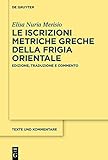Le iscrizioni metriche greche della Frigia orientale : Edizione, traduzione e commento / Elisa Nuria Merisio.
Material type: TextSeries: Texte und Kommentare : Eine altertumswissenschaftliche Reihe ; 73Publisher: Berlin ; Boston : De Gruyter, [2023]Copyright date: ©2024Description: 1 online resource (XII, 567 p.)Content type:
TextSeries: Texte und Kommentare : Eine altertumswissenschaftliche Reihe ; 73Publisher: Berlin ; Boston : De Gruyter, [2023]Copyright date: ©2024Description: 1 online resource (XII, 567 p.)Content type: - 9783110795400
- 9783110796551
- 939.2/6 23/eng/20240103
- CN415.P4 M47 2024
- online - DeGruyter
- Issued also in print.
| Item type | Current library | Call number | URL | Status | Notes | Barcode | |
|---|---|---|---|---|---|---|---|
 eBook
eBook
|
Biblioteca "Angelicum" Pont. Univ. S.Tommaso d'Aquino Nuvola online | online - DeGruyter (Browse shelf(Opens below)) | Online access | Not for loan (Accesso limitato) | Accesso per gli utenti autorizzati / Access for authorized users | (dgr)9783110796551 |
Browsing Biblioteca "Angelicum" Pont. Univ. S.Tommaso d'Aquino shelves, Shelving location: Nuvola online Close shelf browser (Hides shelf browser)

|

|

|

|

|

|

|
||
| online - DeGruyter Gerecht und fair? : Die Empfehlungspraxis des österreichischen Kunstrückgabebeirats im Lichte der Washingtoner Prinzipien / | online - DeGruyter Wege und Seitenwege der Philosophie : Von Anaximander bis Wittgenstein / | online - DeGruyter Diminutives across Languages, Theoretical Frameworks and Linguistic Domains / | online - DeGruyter Le iscrizioni metriche greche della Frigia orientale : Edizione, traduzione e commento / | online - DeGruyter Maqāmāt al-barbīr / | online - DeGruyter Archiv für Geschichte des Buchwesens. Band 78, 2023 / | online - DeGruyter Women of Chinese Modern Art : Gender and Reforming Traditions in National and Global Spheres, 1900s–1930s / |
Frontmatter -- Premessa -- Indice -- Introduzione -- Edizione e commento. Part 1 -- Edizione e commento. Part 2 -- Riferimenti bibliografici -- Sigle e abbreviazioni epigrafiche -- Tabula comparationis -- Incipitarium -- Index verborum -- Index locorum -- Index nominum et rerum notabilium
restricted access online access with authorization star
http://purl.org/coar/access_right/c_16ec
Il libro offre una nuova edizione e, per la prima volta, un approfondito commento linguistico-letterario delle iscrizioni metriche greche della parte orientale della Frigia (Asia Minore) in età romana. Lo studio ha lo scopo di rivalutare le iscrizioni all’interno della storia della lingua e della letteratura greca, e di fornire un contributo allo studio della diffusione della paideia in una delle zone più periferiche dell’Impero.
This book presents an edition of Greek metrical inscriptions from eastern Phrygia (modern Turkey), accompanied by a translation and commentary. It is a corpus of ca. 100 funerary, honorary and votive epigrams from the 2nd- 5th c. CE. The commentary is centered on their linguistic, philological and literary features. It analyses several phenomena related to the late stage of Greek language development and to the spoken language. As regards the literary tradition, even though the Homeric poems are the primary models for most epigrams, the commentary highlights the occurrence of several terms and expressions found in later (epic and non-epic) works, often reflecting a Christian background. The book shows the relevance of the study of metrical inscriptions from Asia Minor as a means to enhance our knowledge of the spread of education and literary culture in the area even in the late Roman Empire. The inscriptions analyzed are not only invaluable linguistic documents, but also play an important role both as pioneering texts reflecting the emergence of a new literary style and as reliable and enduring testimonies to the cultural influence of the Greek literary tradition in places and periods very remote from its original context.
Issued also in print.
Mode of access: Internet via World Wide Web.
In Italian.
Description based on online resource; title from PDF title page (publisher's Web site, viewed 26. Apr 2024)


